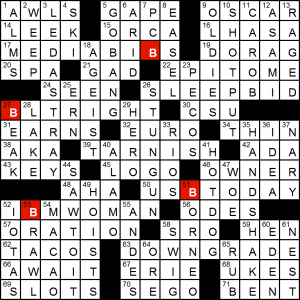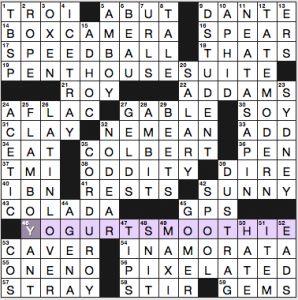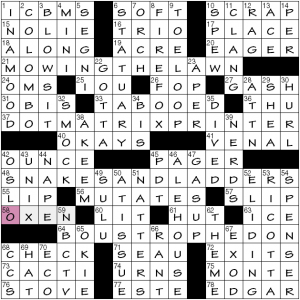Happy Black Panther release day, everyone!
David Steinberg’s New York Times crossword—Amy’s write-up
This 70-worder has lots of sparkle, but also the super-crusty AGENA and ONE NO (crossing, no less! good luck to you if you don’t know your crosswordese rocket things and bridge terminology). Lots of sprawling sections with long fill, though, and good flow from area to area.
Seven things:
- 14a. [Brownie, for one], BOX CAMERA. Old school! We would also have accepted BAKED GOOD and GIRL SCOUT.
- 17a. [Dangerous cocktail], SPEEDBALL. Not booze, but hard drugs. David likes to evince that “edgy college dude” vibe with drugs and sex references in his puzzles. (See also: PENTHOUSE SUITE starting with a porn magazine and making me fear the worst.) I’m over it.
- 32d. [Rejection of a honey-do list], “NO, DEAR.” This is a junk entry. This isn’t an in-the-language phrase. There was a sitcom called Yes, Dear. There will never be one called No, Dear.
- 54a. [Fiancée, say], INAMORATA. Why is INAMORATO so much less common a word? See also: 26d. [Epitome of romantic passion], LATIN LOVER—ugh, stereotypes are so tiresome. Why does anyone still use that term?
- 10d. [One with a plant-based diet], APHID. Okay, let’s call vegans “aphids” from now on. I like aphids! (Note: not a gardener.)
- 35d. [Its ribs stick out], CORDUROY. Great clue!
- 49d. [Long dress], MAXI. I filled in SARI first, and then backtracked to *A*I till I saw what the crossings are. The book I’m reading now is essays by Scaachi Koul, One Day We’ll All Be Dead and None of This Will Matter. She’s a Canadian of Kashmiri descent, and has a long essay about traveling to India for a cousin’s wedding. There is ample coverage of her difficulty finding clothes that fit her body there, her unhappiness with SARIs, the dated gender norms in wedding traditions, and so much more. (Other essays cover growing up brown in a mostly white area, dealing with an alcoholic college buddy, and more. Funny, dark, honest. Recommended reading!)
Shiny bits: YOGURT SMOOTHIE, TATE MODERN, FLAMBOYANT, GOMER. That last one—do people use that much outside of medical circles? A nurse mentioned “the gomers” to me, which surprised me because that’s not a word healthcare professionals are supposed to let slip to patients, is it? I commented on it, and she recommended GomerBlog, a medical humor site. The dictionary suggests it’s also used to insult trainees in the military. [Cloddish sort, in slang] doesn’t mesh with the meanings I know.
Four stars from me.
Peter Koetters’ Chronicle of Higher Education crossword, “It Works Both Ways” — pannonica’s write-up
“The orthographic world of ancient Greece was a sparse old place. A literate Greek of Homer’s time reading a contemporary manuscript would be faced with an UNBROKENSTREAMOFLETTERS, all of the same upper case (because at that time there was no other case); not only that, but texts were composed in a style called boustrophedon, or ‘ox-turning’, where the lines ran alternately left-to-right and then right-to-left across the page in the manner of a farmer driving his oxen across his field. Perhaps most cruelly, the visual signposts of punctuation which today we take for granted were completely absent, and it was the reader’s unenviable lot to tease out words, clauses and even sentences from this densely-packed zig-zag of characters.”
–from Keith Houston’s Shady Characters (book and website)
- 64aR [Ancient text written in alternating directions, later suggested by 21. 37 and 48 Across] BOUSTROPHEDON. 58a [Plowing team referenced in the Greek etymology of 64 Across] OXEN; damn, just noticing as I write this that the connection here is explicit. I’d thought I was so clever for already knowing that and noticing the entry.
- 21a. [Outdoor chore often done in a 64 Across pattern] MOWING THE LAWN.
- 37a. [Noisy computer peripheral that used a 64 Across pattern] DOT MATRIX PRINTER.
- 48a. [Board game in which pieces proceed in a 64 Across pattern] SNAKES AND LADDERS.
Not mentioned in the above excerpt is that not only was the direction of text flow reversed, but the letters themselves were reflected, mirror-image style.
- 17a [Come in second, maybe] PLACE. As anyone who’s seen The Sting will most likely never forget.
- 75a [Sidewalk scam] MONTE. In which direction does the confidence go in a ‘con game’? 16a [Cards in 75 Across, e.g.] TRIO.
- 19a [One of the back forty] ACRE. To be plowed, no doubt.
- 33a [Identified as off-limits] TABOOED. Wasn’t aware it was verbable. Perhaps no-one talks about it?
- Colorful terms in clues: 26a [Popinjay] FOP, 60a [Sozzled] LIT, 11d [Tintinnabulate] CLANG.
- 2d [South Asian capital where Arthur C. Clarke is buried] COLOMBO. Trivia!
“Clarke emigrated from England to Sri Lanka (formerly Ceylon) in 1956, largely to pursue his interest in scuba diving. That year he discovered the underwater ruins of the ancient Koneswaram temple in Trincomalee. Clarke augmented his fame later on in the 1980s, from being the host of several television shows such as Arthur C. Clarke’s Mysterious World. He lived in Sri Lanka until his death. He was knighted in 1998 and was awarded Sri Lanka’s highest civil honour, Sri Lankabhimanya, in 2005.” –Wikipedia
(35d [Hunted for pearls, maybe] DIVED.)
54d [Author entombed near Chaucer in 1599, thus creating Westminster Abbey’s Poets’ Corner] SPENSER. O he of recent EYE-PIT renown. - 5d [Score marks prescribing repeats] SEGNI. Interesting that m-w lists the plural of segno as segnos—not even mentioning an alternative—while Ngrams tells a very different story.
- 32d [Coat of paint?] SMOCK. Cute.
- 34d [La Scala shout calling for an encore] BIS. Literally, “twice” in Italian. Literally, “twice” in Italian.
>bows<
David Alfred Bywaters’ LA Times crossword – Gareth’s write-up

LA Times
180216
I admired the way the A to B changes worked in this DOWNGRADEing theme, although none of the results really tickled me: <>MEDIABIAS becomes MEDIABIBS; ALTRIGHT BLTRIGHT; USATODAY USBTODAY; IAMWOMAN IBMWOMAN.
Gareth


Rex Parker made a similar “What’s up with GOMER as slang?” statement.
I can attest to hearing it used as an insult per the clue in my high-school days. Some, uh, time ago. :)
Besides COS/ONENO/AGENA, AMBOY/ROY and INAMORATA/EADS are problematic as well. Really nice puzzle though. The LAT (with visions of yesterday’s BEQ) and CHE were very enjoyable solves.
Seconding the love for the LAT, really nicely done!
Gomer is an INTENSELY derogatory medical-slang term!!!! Get Out Of My Emergency Room. See “The House Of God” for one reference.
I learned GOMER from watching SCRUBS–
Definition taken from an episode of Scrubs.
“Dr. Cox: Oh! Looky here! Tell me, sir, what is it that brings Dr. Dorian’s favorite gomer back to the hospital?
Gomer: Pickles!”
Whether wittingly or un-, the CHE borrowed heavily from Patrick Merrell’s Puzzle #2 at 2012 ACPT, which also used MOWINGTHELAWN and DOTMATRIXPRINTER as examples of BOUSTROPHEDON. But rather than just offering a curious bit of trivia as the CHE does, Merrell actually designed the *grid itself* in a boustrophedon pattern, with the Across rows alternately proceeding left-to-right and right-to-left (so that almost half of the Across entries were backwards). *Much* more thematically satisfying (and challenging!) than the CHE’s version.
Nice observation. I didn’t experience that crossword, so the write-up (forthcoming) will turn my plow only to what’s at hand.
Wow (Peter here, the CHE constructor). Wish I had been there for that puzzle. Nope, had no idea that was used before. I avoided using the crazy back-and-forth pattern of actual boustrophedon feeling it would be just TOO hard and frustrating. I’m duly impressed at the idea of that construction, though !!
I never use GOMER in its acronymic sense, even in private conversation with other medical folk. That said, I have heard it used in the way it’s defined here – I think that’s where Gomer Pyle got his name.
My wife has never mentioned the word GOMER to me, as far as I can remember. As a young pediatrician, she was more likely to see (and yes, use) the acronym FLK (funny-looking kid). Now that she’s a senior developmental pediatrician, she avoids such derogatory terminology of course.
Until reading the comments today both here and on Rex’s blog, I hadn’t the foggiest notion that GOMER had any connotations unrelated to GOMER Pyle of “The Andy Griffith Show.” Does anyone seriously doubt that that was the reference intended by today’s puzzle?
EDIT: I mean, I’ve heard GOMER used as derogatory slang (in non-medical contexts). But I always assumed it to be a reference to the television character. Today was the first I’ve heard of the acronym.
I always thought it was inside baseball. It was immortalized by the book “The House of God” more than 30 years ago, along with such aphorisms as “take your own pulse first,” “the patient is the one with the disease,” and “if you don’t take the temperature you can’t take the fever.” The book was both funny as hell and very disturbing, and it was an accurate portrayal of medical training in that era.
And yes, Jim, GOMER applies primarily to older patients – in the book it refers to elderly people sent to the ER from nursing homes. Wouldn’t come up much in pediatrics.
Anyone remember Gomer Pyle U.S.M.C.?
Jenni, for one, did. Several hours prior, at least.
re: nyt and AGENA — context is everything. am currently reading rise of the rocket girls, a so-so telling of a *great* story: the contribution of women “computers” to space exploration, starting in the 1940s, w/ the pre-nasa formation of the jpl. just finished reading about the AGENA-atlas combo and its role in the mariner missions, so enjoyed seeing the reference. so, yeah. context.
and timing!
;-)
So TACOS are Tuesday fare? Okay, I googled it and it seems that it’s a Tuesday thing in some restaurants. That little corner of the LAT was tough. Good job!
I liked that LATIN LOVER was preceded by FLAMBOYANT.
All the puzzles were excellent today, affording me a plausible excuse to put off working on a summary I need to write.
CHE has an extra-large 16×16 grid — perhaps in honor of February 16?
64A:BOUSTROPHEDON was my first entry in the grid (see also this mini-puzzle). This made the rest pretty easy. Possibly interesting wrong turn: “stone art” for 6D:STATUARY — I had exactly the four letters filled in that were consistent with both answers.
Unfortunate to cross 72A:EXITS with 67D:EXOD[us] which means “exit” and must be etymologically related. I couldn’t find a quick fix, though Brad’s 52/53/54D seem to offer some scope for local modifications there.
Enjoy the long weekend (and the arguments on whether and where “Presidents Day” has an apostrophe),
–NDE
Re: LAT – Also a themer is 26A SLEEPBID. Four of the themers tickled me.